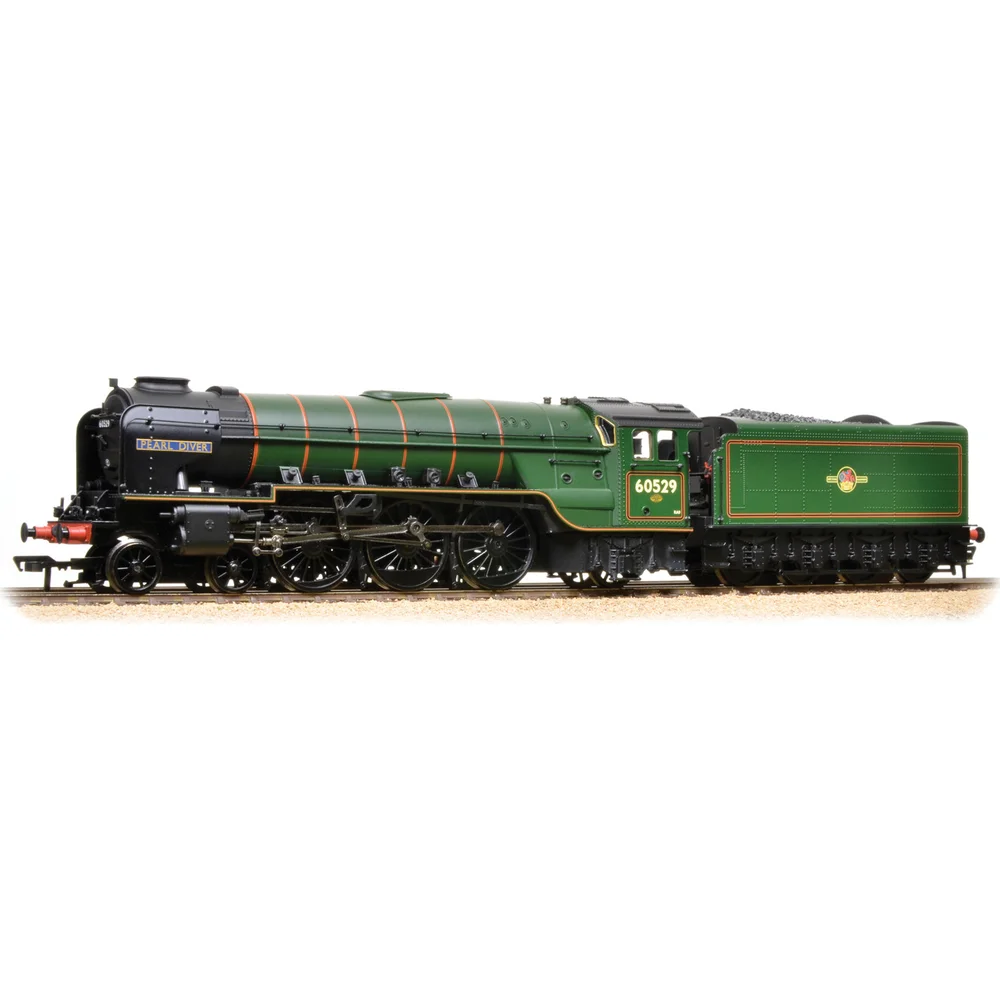Bachmann 31-528A
London & North Eastern Railway A2 Peppercorn 60529 "Pearl Diver" British Railways Lined Green with Late Crest
Tooling
In 2012, Bachmann Branchline introduced an upgraded tooling for its OO gauge model of the LNER Peppercorn A2 Pacific locomotive. This revision built upon the original 2010 tooling, enhancing digital control compatibility and refining mechanical and cosmetic aspects. The upgrade was part of Bachmann’s ongoing commitment to improving its steam locomotive range for modern model railway standards.
Tooling Features
- Scale: OO Gauge (1:76)
- Construction: Screw-assembled body with cast metal footplate and cab, plastic boiler, and metal chassis components.
- Detailing: Factory-fitted handrails, pipework, safety valves, whistles, fluted connecting rods, painted cab interior with fallplate and glazing, and pre-fitted bufferbeam detail.
- Couplings: NEM pockets with tension lock couplings; cosmetic hook coupling on bufferbeam.
- Tender: Riveted tender with painted wheels, brake rigging, and easy-to-use coupling to locomotive.
Mechanical & Electrical
- Motor: 3-pole motor located in the locomotive body.
- Drive: Loco-driven with pickups on driving wheels only.
- Minimum Radius: Suitable for second radius curves (approx. 438mm).
- Weighting: Internal chassis weighting for improved traction.
- Lighting: No factory-fitted lighting; some users added aftermarket lamps and firebox LEDs.
DCC Capability
- Socket: DCC Ready with upgraded 21-pin socket (replacing the 8-pin from 2010).
- Sound: No factory sound; users have retrofitted ESU and Zimo sound decoders with speakers in the tender.
- Additional Modifications: Some enthusiasts added stay-alive capacitors, cab lighting, and tender pickups.
Liveries Produced
- BR Lined Green with Late Crest (e.g., 60529 "Pearl Diver")
- BR Lined Green with Early Emblem (e.g., 60536 "Trimbush")
Reviews & Commentary
- Model received positively for improved DCC compatibility and overall finish.
- Minor cosmetic issues noted, such as bent handrails and paint abrasion, but generally praised for accuracy and running quality.
- RMweb users highlighted ease of cab and tender modifications, and improved performance with added weight and pickups.
Media & Social Media
- Video reviews on YouTube (e.g., Sam’s Trains, PN Trains) praised the model’s detailing and running performance.
- Custom sound and lighting installations shared by hobbyists demonstrated the model’s flexibility for enhancement.
Additional Notes
- The 2012 upgrade was a direct response to growing demand for 21-pin DCC compatibility and better integration with modern digital systems.
- Some models retained the 8-pin socket due to transitional production decisions; buyers were advised to check specifications before purchase.
Class & Prototype
- Class: London & North Eastern Railway A2 Peppercorn
- Traction: Steam
- Built: 1947-1948
- Total Built: 15
- Running Number: 60529
- Name: Pearl Diver
- Ordered By: London & North Eastern Railway
- Built By: British Railways
- Built At: Doncaster
- Built: 02/1948
- Withdrawn: 12/1962
- Length of Service: 14.8 years
- Running Numbers: LNER 529, BR 60529
- Names: Pearl Diver
Operator & Livery
- Operator: British Railways
- Livery: Lined Green with Late Crest
British Railways transformed Britain's fragmented rail network into a unified national system following nationalisation on 1st January 1948. Created from the "Big Four" companies under the Transport Act 1947, BR operated most of Great Britain's railways until rebranding as British Rail in 1965, managing over 20,000 route miles and inheriting nearly 20,000 locomotives of diverse designs.
The organisation pioneered standardisation through its revolutionary BR Standard locomotive programme (1951-1960), producing 999 advanced steam engines under Robert Riddles' direction. These included the versatile Britannia Pacifics, mighty 9F freight engines, and mixed-traffic classes that incorporated the best features from all predecessor companies. The 1955 Modernisation Plan accelerated diesel and electric traction development, creating fascinating mixed-traction operations.
Notable achievements included establishing unified locomotive classification systems, introducing distinctive corporate liveries, and managing the complex transition from steam to modern traction. BR's six regional structure preserved operational diversity whilst enabling standardisation of practices, signalling, and rolling stock that had eluded private enterprise for over a century.
The BR era represents steam traction's final flowering alongside emerging diesel technology, creating unparalleled locomotive variety. Today, this heritage remains highly popular with railway enthusiasts through extensive preserved fleets, heritage railway operations, and comprehensive model ranges from manufacturers like Hornby, Bachmann, and Dapol, making BR subjects essential for authentic post-war British railway modelling across all scales.
British Railways' lined green livery continued for express passenger locomotives from 1956, painted in BS224 Deep Bronze Green (also known as Land Rover Deep Bronze Green) with orange and black lining, maintaining the prestigious finish for the railway's premier motive power. The livery was reserved for the most powerful express passenger classes, including Britannias, Castles, Kings, A4s, Merchant Navy Pacifics, and other premier locomotives rated for top-link express duties. From 1954 onwards, green became more widely adopted across the locomotive fleet, with some mixed-traffic engines also receiving the prestigious finish as regional freedom in livery matters increased following the 1953 Transport Act.
From mid-1956, these locomotives received the new "Lion and Crown" emblem (nicknamed the "Ferret and Dartboard"), a proper heraldic device registered with the College of Arms featuring a rampant lion emerging from a crown and holding a spoked wheel, all enclosed in a roundel with "British Railways" on bars either side. The emblem was positioned centrally on tender sides, with the heraldically correct lion facing left, though some locomotives initially received forward-facing applications during the transition period. Lettering and numbering remained in golden yellow Gill Sans Medium, maintaining the high-quality finish appropriate for express passenger duties. Regional variations in the shade of green occurred depending on which works applied the paint, the suppliers used, and the number of paint layers applied, creating subtle differences between locomotive classes and individual engines. This livery represented the final flowering of BR's steam-era corporate identity, combining technical excellence with heraldic dignity during the twilight years of express steam operations before the Rail Blue revolution of the mid-1960s.
